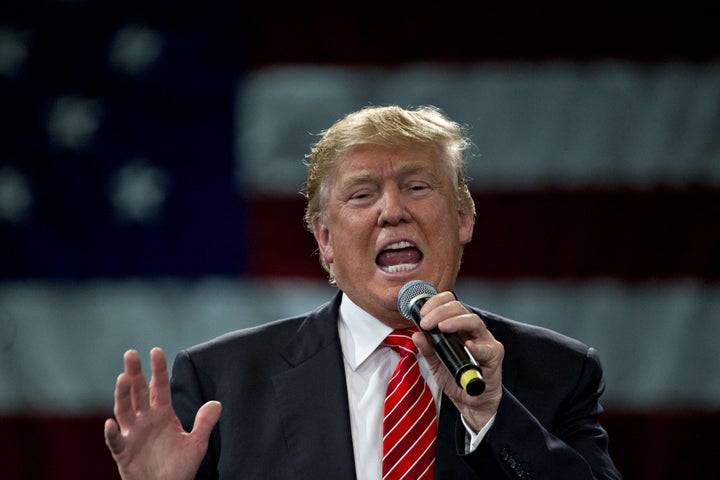
This piece was written for the launch of HuffPost Mexico on Sept. 1.To read this article in Spanish from HuffPost Mexico, click here.
WASHINGTON ― First, Donald Trump vows to build a “great” wall along the 1,989-mile U.S.-Mexico border and make Mexico pay for it. Then Vicente Fox says there is no way his country will pay for a “fucking wall,” and Enrique Peña Nieto compares Trump’s “populism” to that of Hitler and Mussolini. Hillary Clinton, not to be outdone, attacks Trump as a dictatorial bigot, in large part because he called Mexican immigrants to the U.S. criminals, drug dealers and rapists.
Even the appearance of a taco bowl has become a key moment in the U.S. presidential race. Was Trump innocently trying to honor Mexican culture with his Cinco de Mayo tweet, or rudely taunting his critics? (The latter, I confirmed.)
And that was just the start of a North American political melodrama.
On Wednesday ― in the strangest chapter yet, although every chapter has been the strangest chapter yet ― Trump flew to Mexico City at Peña Nieto’s invitation for a meeting of two men desperate for respect. Trump is way behind in the campaign polls, while Peña Nieto’s approval rating is an abysmal 23 percent.
Peña Nieto had issued a separate invitation to Clinton, but she is wisely staying out of the way for now, the better to watch the Mexican president and the American candidate somehow try to ignore a year’s worth of some of the nastiest rhetoric between the two countries since Santa Anna attacked the Alamo.
And ignore it they did.
Improbably, at least for a time, the two men managed to sound like brothers in arms, linked by a shared desire to block illegal migration from Central and South America and fend off cheap manufacturing imports from outside of North America. As for the dangers of a porous border, Trump admitted that “it’s not a one-way street” ― acknowledging that Mexico suffers from an influx of dirty money and arms from the U.S.
“We will work together,” said Trump, sounding, for the moment at least, like the kind of let’s-paper-things-over politician that he has built his campaign on denouncing.
Oh, and one other thing: By his own account, Trump did not bring up the indelicate topic of who would pay for a border wall, should one ever be built. “We didn’t discuss” it, said Trump, even though it has been one of the two constants of his ever-changing immigration platform.
Tweeting later, Peña Nieto dropped the diplomatic niceties and insisted that the two had indeed discussed who would pay for the wall ― and that the Mexican position was that it would never be Mexico. In other words, Peña Nieto implied, his American guest was a liar.
Trump evidently surprised Peña Nieto by accepting the invitation and racing to Mexico City before the Mexican president could change his mind. He was rewarded with controlled but gracious words from Peña Nieto, who could hardly greet his guest by calling him a fascist.
Instead, Peña Nieto said that despite Trump’s harsh words in past months, the American billionaire had displayed a “genuine interest in our society’s mutual well-being” ― which, obviously, remains to be seen.
Mexican citizens don’t vote in U.S. elections, of course. But this year, Mexico itself has taken center stage in the U.S. to a degree that’s causing strain in both countries. There is dark humor to be enjoyed, but when Mexico becomes a central issue here, it’s usually a sign that politics have become scary and a little crazy in El Norte.
When Americans vote this November, they will not only choose a new president (and Congress), but open a new chapter in a long, often contentious relationship with the country to their immediate south ― a history that includes a shooting war over Texas in the 19th century and a war of words over trade in the late 20th.
This year, U.S. citizens of Mexican heritage who live and vote in strategically important states could well decide the outcome of the presidential race.
And U.S. policy toward Mexican immigrants hangs in the balance, as America goes through one of its periodic outbreaks of xenophobia, spurred by security concerns and historically high levels of immigration from around the world.
It is easy to pinpoint the moment when 2016 became the Mexico Election.
On June 16, 2015, a pudgy man with tangerine-colored hair rode a gold-toned escalator down to the lobby of the office tower he had named for himself on Fifth Avenue in New York City. There, surrounded by TV cameras and pink marble, he declared his candidacy for the U.S. presidency ― and his own personal war against the country and people of Mexico.
Mexico, Trump said that day, was “sending” people north “who have a lot of problems. They’re bringing drugs. They’re bringing crime. They’re rapists.”
The solution, he said, was to quickly find and deport the estimated 11 million unauthorized immigrants in the U.S. ― a group that includes millions of people from Mexico ― and to build a three-story wall along the border. Trump would force Mexico to pay for the wall, he said, by threatening to cut off private remittance payments by Mexican immigrants.
Trump’s presidential candidacy was initially dismissed as a sideshow, a vanity project from a reality-TV entertainer and shifty real estate mogul who shouted from the paranoid fringes of American politics.
But Trump’s accusatory, inflammatory approach eventually made him the Republican presidential nominee, and now he is facing off in the final round against Clinton, the Democratic leader of a brand-name machine with decades of experience and contacts.
The strategy that got Trump through the primaries, though, is now suppressing his chances in the general.
Trump is behind in the race, flagging in several of the key states he would need to win under the U.S. electoral system. As of Aug. 30, The New York Times put the odds of Trump winning the White House at just 12 percent.
True, immigration remains a top-five issue in the race. But 72 percent of all Americans favor finding a way for undocumented immigrants to “legally stay” in the U.S. And only 38 percent support the construction of a wall along the Mexican border.
The poll numbers matter for several reasons ― and they are poison for Republicans.
For one thing, Hispanics in general, and Mexicans in particular, are the largest minority group in the United States today. There are 60 million Latinos in the U.S., of whom some 35 million declare themselves to be of Mexican descent.
For another, about half of the estimated 11.5 million undocumented immigrants in the U.S. are from Mexico.
When Trump disparages Mexican immigrants, therefore, he is attacking a much wider ― and very influential ― group of legal American voters.
It is no way to win the “Hispanic vote.”
The general rule in American politics is that a Republican cannot win the presidency without garnering at least 40 percent of the Hispanic vote. President George W. Bush barely won in 2004 and got about 44 percent of that vote. In 2008, Sen. John McCain got 30 percent and lost. In 2012, Mitt Romney got 27 percent and lost.
“Right now it looks like Trump is going to set a new modern low ― 25 percent,” said Simon Rosenberg of the New Democratic Network, a Washington think tank that studies immigration.
In May, as Trump was wrapping up the GOP nomination, his then-campaign chairman dismissed the idea that the candidate would have to reach Bush-like levels of Latino and Mexican support.
Since most Latinos in general and Mexicans in particular are located in states such as California, New York and Texas ― none of which are competitive in the U.S. Electoral College ― the overall national number doesn’t matter, Paul Manafort told me. What matters is that Trump win support in states with smaller numbers of Mexicans and Latinos. There, he claimed, Hispanic voters will be less likely to base their votes on ethnic solidarity and won’t be so easily swayed by liberal Hispanic activists.
Manafort has since been fired, and his replacements know that Trump will continue to drive away Hispanics ― and moderate Anglo voters ― if he maintains his hard line on Mexico and immigration.
So in the past two weeks Trump has been trying to modulate, or at least obscure, his past positions.
The wall remains an unchanged part of his agenda. So does his theory that he can force Mexico to pay for it. So does his alleged determination to “immediately” find and deport “the bad ones” ― those undocumented immigrants with criminal records or other serious problems.
But he has stopped attacking – or even mentioning – Gonzalo Curiel, a federal judge born in the U.S. who Trump had said was inherently biased against him because his parents emigrated from Mexico.
And Trump now says he has sympathy for undocumented immigrants who have been in the U.S. for many years and lead quiet, productive lives.
Voters at his rallies, he says, are pleading for them.
“They’ve said, ‘Mr. Trump, I love you, but take a person that has been here for 15-20 years, and now throw them and their family out? It’s so tough,’” he said last week.
It seems unlikely that Trump has had a genuine change of heart. One suspects, rather, that his new team of advisers have simply taken a closer look at the Electoral College and noted that Hispanics are a key voting bloc in many parts of the country Trump badly needs to win.
Meanwhile, as Trump works to “modify” his stand, Hillary Clinton continues to make it clear that she favors a “path to citizenship” for undocumented immigrants. And she is carefully ― some might say obsessively ― targeting Hispanic voters as she works the states.
She picked as her running mate Tim Kaine, the governor of Virginia ― one of the states up for grabs in the Electoral College ― and a fluent speaker of Spanish. Kaine is also a Catholic, like two-thirds of Mexican-Americans, and has traveled and worked widely in Latin America.
Plus, as Clinton plans for what she hopes will be a victory in November, she has named as her “transition” chief Ken Salazar, a former Colorado attorney general, U.S. senator and secretary of the interior.
He is of Mexican-American heritage ― except that his family emigrated from Spain to what was then New Spain about 400 years ago.
That was about 300 years before Donald Trump’s ancestors arrived in New York from Germany.
Clarification: Language has been amended to more accurately describe the United States’ 19th-century conflict with Mexico.
Editor’s note: Donald Trump regularly incites political violence and is a serial liar, rampant xenophobe, racist, misogynist and birther who has repeatedly pledged to ban all Muslims — 1.6 billion members of an entire religion — from entering the U.S.
